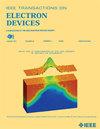金属氧化物半导体(MOS)器件在Si衬底上生长高空穴迁移率稳定的ST12-Ge薄膜
IF 2.9
2区 工程技术
Q2 ENGINEERING, ELECTRICAL & ELECTRONIC
引用次数: 0
摘要
目前的工作是研究在Si衬底上生长高空穴迁移率的ST12-Ge薄膜(5.85 nm),用于MOS器件。微拉曼研究表明,ST12-Ge薄膜产生了3.73 GPa的压应力,吸收光谱结果证实了直接带隙为0.69 eV,间接带隙为0.582、0.634、0.636和0.638 eV。测得薄膜的p型载流子浓度和室温霍尔迁移率分别为$4.49\乘以10^{{18}}$ cm $^{-{3}}$和$1.33\乘以10^{{4}}$ cm2V $^{-{1}}$ s $^{-{1}}$。制备的Pt/ZrO2/ST12-Ge/n-Si MOS器件的C-V测量表明,ZrO2的有效介电常数为16.4,有效氧化厚度(EOT)为~4.09 nm,形成了良好的ZrO $_{{2}}{}$ /ST12-Ge界面,陷阱密度为$2.76\乘以10^{{11}}$ cm $^{-{2}}$ eV $^{-{1}}$。I-V特性在+2 V时漏电流密度为$1.57\ × 10^{{2}}$ a /cm2,在−5 V时漏电流(SILC)为$10^{{2}}$ s,因此,整体研究证实了坚固的ST12-Ge薄膜和ZrO2/ST12-Ge接口的形成,适用于开发具有高通道迁移率的CMOS器件。本文章由计算机程序翻译,如有差异,请以英文原文为准。
Growth of High-Hole Mobility Stable ST12-Ge Thin Film on Si Substrate for Developing Metal-Oxide–Semiconductor (MOS) Devices
The current work investigates the growth of high-hole mobility ST12-Ge thin film (5.85 nm) on Si substrate for its applications in MOS devices. Micro-Raman study indicates the generation of 3.73 GPa induced compressive stress in such ST12-Ge films and the absorption spectroscopy results confirm a direct bandgap of 0.69 eV and indirect bandgaps of 0.582, 0.634, 0.636, and 0.638 eV. The p-type carrier concentration and room temperature Hall mobility of the film are measured to be $4.49\times 10^{{18}}$ cm $^{-{3}}$ and $1.33\times 10^{{4}}$ cm2V $^{-{1}}$ s $^{-{1}}$ , respectively. C–V measurements of the fabricated Pt/ZrO2/ST12-Ge/n-Si MOS devices indicate a highly effective dielectric constant of 16.4 for ZrO2 with an effective oxide thickness (EOT) of ~4.09 nm along with the formation of a good ZrO $_{{2}}{}$ /ST12-Ge interface of trap density $2.76\times 10^{{11}}$ cm $^{-{2}}$ eV $^{-{1}}$ . The I–V characteristics exhibit a low leakage current density of $1.57\times 10^{-{2}}$ A/cm2 at +2 V and an insignificant stress-induced leakage current (SILC) at −5 V for $10^{{4}}$ s. Therefore, the overall study confirms the formation of a robust ST12-Ge film and ZrO2/ST12-Ge interface, which is suitable for developing CMOS devices with high channel mobility.
求助全文
通过发布文献求助,成功后即可免费获取论文全文。
去求助
来源期刊

IEEE Transactions on Electron Devices
工程技术-工程:电子与电气
CiteScore
5.80
自引率
16.10%
发文量
937
审稿时长
3.8 months
期刊介绍:
IEEE Transactions on Electron Devices publishes original and significant contributions relating to the theory, modeling, design, performance and reliability of electron and ion integrated circuit devices and interconnects, involving insulators, metals, organic materials, micro-plasmas, semiconductors, quantum-effect structures, vacuum devices, and emerging materials with applications in bioelectronics, biomedical electronics, computation, communications, displays, microelectromechanics, imaging, micro-actuators, nanoelectronics, optoelectronics, photovoltaics, power ICs and micro-sensors. Tutorial and review papers on these subjects are also published and occasional special issues appear to present a collection of papers which treat particular areas in more depth and breadth.
 求助内容:
求助内容: 应助结果提醒方式:
应助结果提醒方式:


